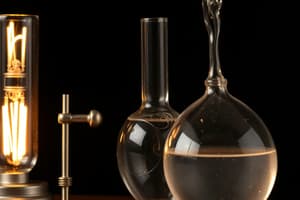Podcast
Questions and Answers
What is Boyle's Law and what does it state?
What is Boyle's Law and what does it state?
Boyle's Law states that as long as the temperature is held constant, the pressure and volume of a gas are inversely proportional to each other. Meaning, if one increases, the other one decreases.
What does Boyle's law state?
What does Boyle's law state?
Boyle's law states that for an ideal gas held at a constant temperature, the product of the pressure and volume must be constant, showing an inverse relationship between pressure and volume.
What are the two factors used in Boyle's law?
What are the two factors used in Boyle's law?
The two factors used in Boyle's law are pressure and volume.
Give an example of a real-life application of Boyle's law.
Give an example of a real-life application of Boyle's law.
What does Boyle's Law state?
What does Boyle's Law state?
How can Boyle's Law be expressed in equation form?
How can Boyle's Law be expressed in equation form?
If a container filled with an ideal gas at 2 atm occupies 2L of space, and the volume is doubled to 4L, what is the pressure inside the container?
If a container filled with an ideal gas at 2 atm occupies 2L of space, and the volume is doubled to 4L, what is the pressure inside the container?
According to Boyle's Law, what is the relationship between the pressure and volume of a gas?
According to Boyle's Law, what is the relationship between the pressure and volume of a gas?
What is the equation that represents Boyle's Law?
What is the equation that represents Boyle's Law?
If a balloon at sea level with a volume of 1 liter experiences a decrease in pressure to 0.5 atmospheres, what will be the final volume of the balloon?
If a balloon at sea level with a volume of 1 liter experiences a decrease in pressure to 0.5 atmospheres, what will be the final volume of the balloon?
According to Boyle's law, what is the relationship between the pressure and volume of an ideal gas?
According to Boyle's law, what is the relationship between the pressure and volume of an ideal gas?
How does Boyle's law explain the relationship between volume and pressure in a gas?
How does Boyle's law explain the relationship between volume and pressure in a gas?
How does Boyle's law relate to the behavior of gases in the human body?
How does Boyle's law relate to the behavior of gases in the human body?
According to Boyle's law, what is the relationship between pressure and volume of an ideal gas at a constant temperature?
According to Boyle's law, what is the relationship between pressure and volume of an ideal gas at a constant temperature?
If the original pressure of a gas system is 1.2 atm and the final pressure is 2.4 atm after the volume has been adjusted, what was the initial volume of the gas?
If the original pressure of a gas system is 1.2 atm and the final pressure is 2.4 atm after the volume has been adjusted, what was the initial volume of the gas?
Johnny's air-filled scuba vest holds 1.43 liters of air at 1.03 atmospheres of pressure. What volume of air will it hold at 10 meters underwater, which is equivalent to about 2.03 atmospheres?
Johnny's air-filled scuba vest holds 1.43 liters of air at 1.03 atmospheres of pressure. What volume of air will it hold at 10 meters underwater, which is equivalent to about 2.03 atmospheres?




